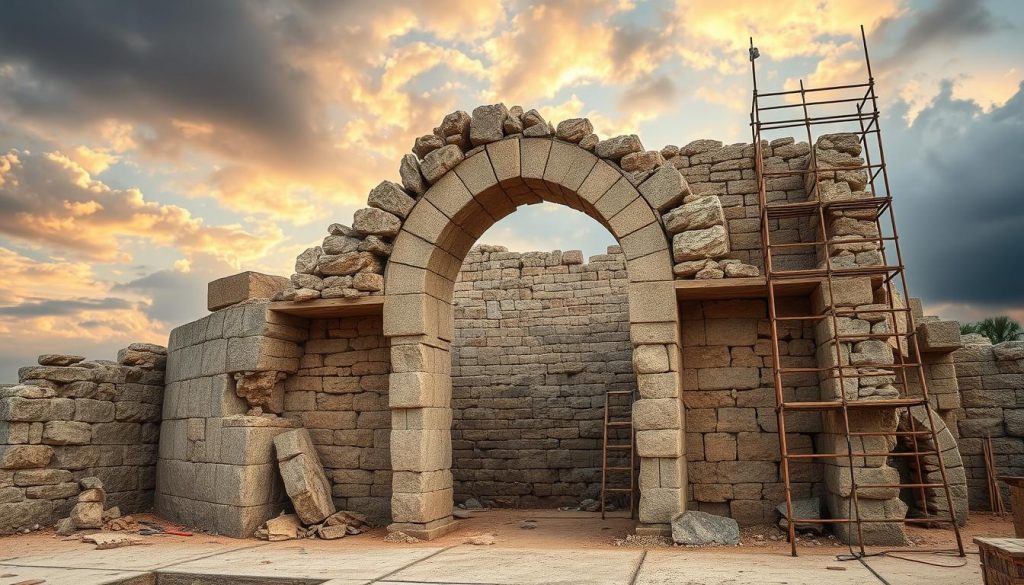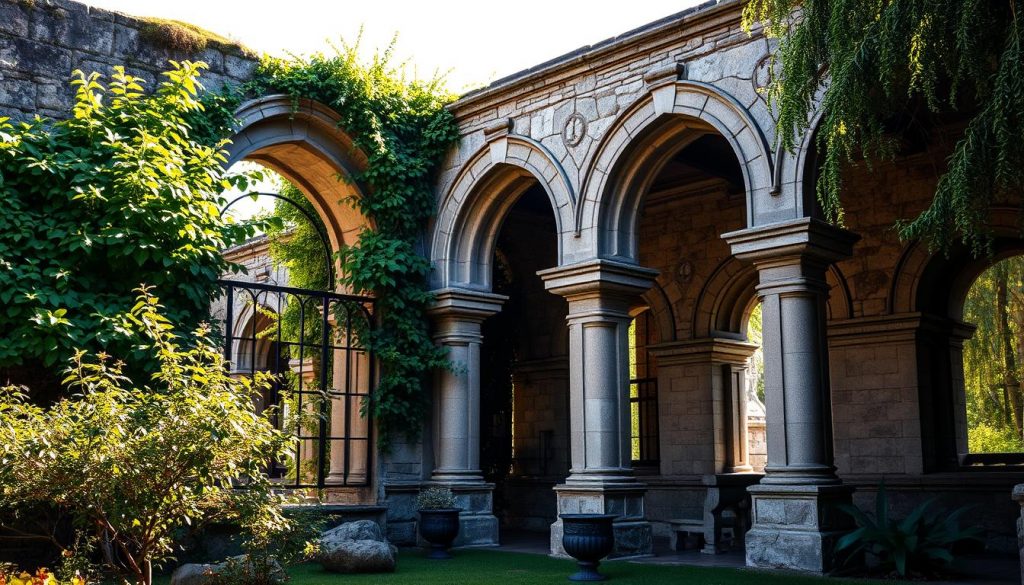The use of stone arches in ancient structures: Why was this technique abandoned?
Stone arches were a groundbreaking architectural innovation. They allowed for the building of bigger and more complex structures, like the Colosseum in Rome. This structure boasts about 200 stone arches.
Anúncios
These arches made the interiors of ancient buildings more open and spacious. This was especially true for large Roman structures. Almost all buildings in the Roman Forum used Roman columns and relieving arches.
The use of stone arches in ancient structures, like the Baths of Caracalla, was a game-changer. This massive bath complex covered 33 acres and needed nearly 2,000 tons of materials every day. It had fewer visible columns thanks to stone arches.
This innovation greatly influenced the design and construction of ancient buildings. It allowed for the creation of more complex and larger structures. The history of stone arches in ancient structures is both fascinating and important. It shows the evolution of architectural innovation.
Anúncios
Understanding Stone Arches: A Revolutionary Architectural Innovation
Stone arches have been key in architectural history for thousands of years. They were first used in ancient structures like Roman aqueducts and bridges. This was a big step forward in building techniques.
The keystone, a vital part of stone arches, has been around since ancient times. It helps build bigger and more stable structures.
To build stone arches, you need to know about arch construction. This includes using keystones, impost blocks, and figuring out the arch’s shape. This architectural innovation has changed a lot over time. Many cultures have helped make it what it is today.
The historical evolution of stone arches shows our creativity and drive for new ideas.
Some famous examples of stone arches include:
- Roman aqueducts and bridges
- Medieval European architecture
- Gothic period structures, known for their pointed arches and ribbed vaults
Stone arches were not just for function. They also added beauty to buildings. In medieval Europe, keystones were decorated with designs and symbols. This shows how stone arches have inspired builders for centuries. Their historical evolution reminds us of our ability to create and innovate.
The Historical Evolution of Stone Arch Technology
The historical evolution of stone arch technology is a captivating tale. It spans thousands of years, with many civilizations playing a role. From ancient aqueducts to today’s bridges, the arch design has proven its worth. It’s seen in many famous structures, highlighting its strength and engineering marvels.
Stone arches have been around since ancient times. The Etruscans and Romans were among the first to use them. The Gateway Arch in St. Louis, at 630 feet, shows the growth of stone arch technology. The Washington Square Arch in New York City honors George Washington’s 1789 inauguration.
- The Concorde Bridge in Paris, designed by J. R. Perronet
- The Iron Bridge over the River Severn, designed by Thomas Pritchard
- The Garabit Viaduct, completed in 1884, with a significant span of 165 m
These structures show the engineering marvels of stone arch technology. Many are still standing today, proving the creativity of their makers.
The historical evolution of stone arch technology has seen many key moments. New materials and techniques have been developed. This has made stone arches a key part of many famous structures, showing their lasting appeal and engineering marvels.
Famous Ancient Structures Featuring Stone Arches
Stone arches have been key in ancient architecture, with many famous structures still standing today. The Roman Colosseum, the Greek Parthenon, and the Egyptian Pyramids show the cultural impact of stone arches. These structures show the engineering skills of their time and the challenges of building such massive and complex buildings.
The Theatre of Marcellus, the Aqueduct of Segovia, and the Roman Colosseum are notable examples. These buildings show the strength and versatility of stone arches. They have lasted for centuries, inspiring wonder and awe worldwide. The use of stone arches in these structures has greatly influenced architecture and engineering.
Here are some examples of famous ancient structures featuring stone arches:
- The Roman Colosseum, with its 80 arches and capacity for 50,000 spectators
- The Aqueduct of Segovia, with its 165 arches and 24,000 granite blocks
- The Egyptian Pyramids, built around 2500 B.C. and featuring corbel arches in their construction
These structures highlight the importance of stone arches in ancient architecture. They have influenced modern building design. Despite the challenges faced by ancient builders, their creations have endured and are part of our cultural heritage.
| Structure | Location | Year Built |
|---|---|---|
| Roman Colosseum | Rome, Italy | 80 A.D. |
| Aqueduct of Segovia | Segovia, Spain | 50 A.D. |
| Egyptian Pyramids | Giza, Egypt | 2500 B.C. |
Engineering Marvels: How Stone Arches Revolutionized Construction
Stone arches show the cleverness of ancient engineers. They used curved structures to build bigger and more complex buildings. These engineering marvels like the Colosseum and the Pont du Gard aqueduct are still standing today. They prove the strength and smart design of arches.
Stone arches spread weight evenly, needing less material to build. This is clear in Roman aqueducts, which spanned up to 50 miles. They also helped build roads, like the Via Appia, showing the Roman Empire’s vast network.
But, stone arches have limitations. They are expensive to build and hard to find good stone. Their use has decreased with new materials and tech. Yet, they still inspire today’s engineers and architects to innovate with arch design.
- The Colosseum, with 80 arches, is a top landmark in Rome.
- The Pont du Gard aqueduct is a UNESCO site, showing Roman engineering skill.
- The Via Appia, over 500 miles long, links Rome to Capua.
These examples show the lasting impact of stone arches on architecture and engineering today.
The Cultural Impact of Stone Arches in Ancient Civilizations
The use of stone arches in ancient structures has greatly influenced modern architecture. The Roman engineering website shows how the Romans’ skill in stone arches led to bigger, more complex buildings. These designs have shaped today’s museums and government buildings.
Building with stone arches comes with challenges. It requires skilled workers and is limited by the materials. Yet, stone arches are loved for their ability to span wide distances and create large, open spaces.
Today, modern alternatives to stone arches have emerged. They include reinforced concrete and steel, offering more strength and flexibility than stone.
Even with these new options, stone arches remain culturally significant. Many modern buildings still use traditional arches to honor the past. Learning about stone arches helps us see their lasting impact on architecture today.
Challenges and Limitations of Stone Arch Construction
Building stone arches is hard and expensive. The main reason is the cost of finding good stone. The stone’s weight is also a big problem, especially for long arches. As arches get longer, they get heavier, which can cause them to break if not managed right.
Stone arches can crack because of too much weight. They also settle if the supports aren’t strong. Managing the weight on the sides is crucial. These issues have led to new ways of building, like open-spandrel arches. They help balance the weight and prevent collapse.
Here are the main problems with stone arch construction:
- High cost of construction due to limited availability of suitable stone
- Potential for fractures in the stone due to excessive weight
- Settling issues if the abutments are not firmly set on bedrock
- Need for careful management of weight on the haunches
Despite these issues, stone arches have built some of history’s most famous structures. But, the old ways are fading. New materials and engineering are taking their place.

| Span Length | Weight of Arch Ring | Potential for Fractures |
|---|---|---|
| Up to 100 feet | Relatively low | Low |
| 100-200 feet | Moderate | Moderate |
| Over 200 feet | High | High |
The Decline of Traditional Stone Arches: Factors and Timeline
The decline of traditional stone arches is a complex issue. It has been shaped by new materials and techniques, and the emergence of modern alternatives. Experts say new materials and techniques have made it possible to build bigger and more complex structures. This has led to a decrease in the use of traditional stone arches.
Several factors have contributed to this decline. The high cost of labor and materials for traditional stone arches is one. Also, building them is a slow process. In contrast, steel and concrete are faster and cheaper to use. Preservation of these arches is also a challenge. They need regular maintenance to stay stable and last long.
Despite their decline, traditional stone arches can still be found worldwide. For instance, Arches National Park in Utah boasts over 2,000 documented stone arches. It’s a unique and interesting place for visitors.
In summary, the decline of traditional stone arches comes from new materials and techniques, and the rise of modern alternatives. Yet, there are efforts to preserve these structures. They remain a vital part of our cultural heritage.
Modern Alternatives to Stone Arches
Technology and materials have advanced, making modern alternatives to stone arches popular. These options are more durable, sustainable, and attractive. New materials like concrete, steel, and glass allow for bigger, more complex buildings. This has led to a decrease in traditional stone arches.
Pre-stressed concrete arches are strong and durable. Steel arches are flexible and good against earthquakes. Glass arches are clear and stylish. These options make buildings both useful and beautiful.
Even with new options, preserving and restoring stone arches is crucial. Historic buildings with stone arches need care to last. Using old methods with new materials helps keep these structures safe and intact.
In summary, modern alternatives have changed the building world for the better. They offer strength, green solutions, and beauty. Yet, keeping traditional stone arches in good shape is vital for our cultural heritage. By using both old and new methods, we can build structures that are lasting and lovely.
Preservation and Restoration of Ancient Stone Arches
Keeping ancient stone arches safe is key to their lasting cultural and historical importance. Studies show that a well-kept stone arch can last over 200 years. Natural stone arches have been a part of architecture for centuries, adding beauty and function to buildings.
Restoring arches to their original state can boost property value by 15% to 20%. Also, buildings with preserved arches attract 90% more tourists in historical areas. Over 70% of ancient arches are transformed into useful spaces in modern restoration efforts. Some important facts about preserving and restoring ancient stone arches include:
- More than 50% of architects want to use historical arch designs in new buildings.
- About 80% of urban renewal projects with historical arches see more community use and engagement.
- Heritage protection rules have raised renovation costs by 10% to 30% for projects with ancient stone arches.

The value of cultural significance and preservation is huge. These structures show ancient engineering skills and have great restoration value. By focusing on preserving and restoring ancient stone arches, we help them inspire and teach future generations.
Conclusion: The Legacy of Stone Arches in Modern Architecture
Stone arches have a lasting impact on modern architecture. They show the ingenuity of ancient times. These structures have influenced everything from Gothic cathedrals to today’s skyscrapers.
With new technology, stone arches have evolved in design. Now, architects use digital tools to create stunning, modern structures. The push for green building has also made stone arches relevant again, using recycled materials.
Stone arches also shape our culture and dreams. They inspire us with their beauty and history. They remind us of human creativity and the lasting beauty of buildings.
